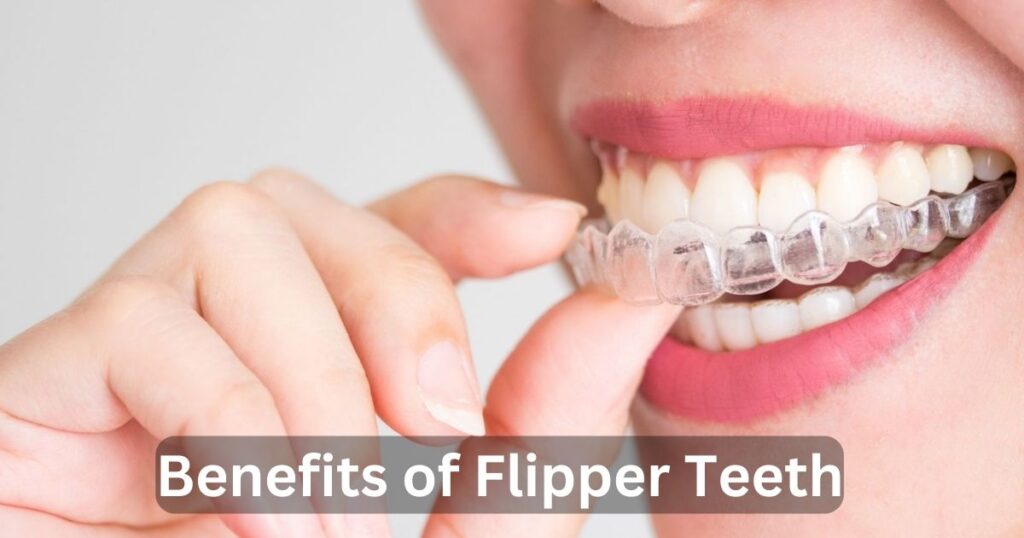A flipper tooth, also known as a removable partial denture, is a prosthetic appliance that replaces one or more missing teeth. Flipper teeth are an affordable and non-invasive solution for restoring your smile. This comprehensive guide will provide an in-depth look at everything you need to know about flipper teeth.
What is a Flipper Tooth?
A flipper tooth, sometimes called a dental prosthesis or temporary partial denture, is a removable acrylic appliance that fits over the gums to fill in the space left by one or more missing teeth. It is held in securely place by the surrounding natural teeth and typically replaces just one or two teeth.
Flipper teeth are a type of removable partial denture – they can be taken out of the mouth for cleaning and care. They offer a temporary means of replacing teeth that have been lost due to injury, decay, or other causes. Flipper teeth present a cost-effective and non-invasive solution until more permanent options like dental implants, bridges, or partial dentures can be considered.
Some key qualities of flipper teeth include:
- Made from acrylic resin material molded to fit your mouth
- Designed to securely snap into place over the gums
- Replaces a single tooth or small span of missing teeth
- Held firmly by the adjacent natural teeth
- Can be removed daily for cleaning and care
- Much more affordable than fixed bridges or dental implants
Flipper teeth have been used for decades as an inexpensive tooth replacement appliance. They provide a simple, non-invasive way to temporarily restore your smile and chewing function while waiting on a permanent solution.
Benefits of Flipper Teeth

There are many benefits that make flipper teeth a practical and cost-effective option for situations where one or two teeth are missing:
Improved Appearance
One of the major benefits of flipper teeth is an improved smile. When teeth are lost, it creates a “sunken” look as the gums recede into the empty space. This collapsed appearance can make you look older and make the face take on a “caved-in” look.
A flipper tooth fills in the gap left by the missing tooth, restoring the natural contour and smile line. The artificial tooth blends with your natural teeth to present a full, symmetrical smile. This greatly improves aesthetic appearance.
Restored Chewing Ability
Losing teeth interferes with your ability to bite, chew, and eat properly. The empty space changes your bite alignment and allows food to collect where teeth are missing.
A flipper tooth fills in the gap, restoring your ability to bite down and chew on both sides of your mouth. This allows you to eat normally without food getting trapped or forced to the other side.
Prevents Teeth Shifting
When a tooth is lost, the nearby teeth will begin to shift and drift over time. This is because teeth naturally tend to tip or tilt towards any gaps. The gap left by a missing tooth will cause gradual rotation and movement of surrounding teeth as they lean into the empty space.
A flipper tooth fills the gap left by the extracted or lost tooth, preventing the adjacent natural teeth from shifting position. This helps maintain proper tooth alignment and your bite.
Low Cost Temporary Solution
Flipper teeth provide a far more affordable tooth replacement option compared to fixed bridges or dental implants. Costing between $100-$500 per tooth, they are an inexpensive way to temporarily fill in missing teeth.
This makes flipper teeth ideal as a short-term solution while waiting on a more permanent restoration. They serve as “placeholder” teeth at a fraction of the cost of an implant or bridge.
Easily Removable
Unlike fixed bridges or implants, flipper teeth are removable prosthetic appliances. They are designed to snap securely into place over the gums but also be removed daily.
This allows for easy cleaning of the flipper tooth itself, the abutment teeth, and the gums underneath. Flipper teeth can be taken out for proper brushing and sanitizing.
Being removable also makes adjusting or relining the flipper easier if needed to maintain a well-fitted seal over time. Overall, the removable nature offers more versatility in cleaning and care.
For those missing one or two teeth, flipper teeth present an affordable and pragmatic solution. They offer considerable benefits as a temporary restoration while pursuing more permanent options.
Cost of Flipper Teeth
Flipper teeth are one of the most economical tooth replacement appliances available. The cost for a flipper tooth ranges from $100 to $500 per tooth replaced. Several factors influence the overall price:
Materials Used
The most basic flipper teeth are made from relatively inexpensive acrylic resin. Higher-end flippers may use more durable flexible nylon resin or highly customized designs. The materials affect cost.
Number of Teeth Replaced
A single tooth flipper costs less to produce than one replacing multiple teeth. The more teeth restored, the higher the price to create the appliance.
Dental Office Fees
Pricing varies based on geographic location and specific dentists. Fees for impressions, fittings, and checkups impact the final bill. Cosmetic dentists often charge more for flippers.
Insurance Coverage
Many dental insurance plans cover a portion of the cost for flipper teeth, typically 50-80% after deductibles. This lowers out-of-pocket expense. Uninsured patients pay the full price.
For a single tooth basic acrylic flipper, expect costs between $250-$400. High-end models or replacements of multiple teeth may range from $500-$1,500 or more. However, flipper teeth remain one of the most budget-friendly tooth replacement options compared to other treatments.
Eating with Flipper Teeth

Flipper teeth allow you to eat and chew most foods normally. However, some care should be taken to prevent dislodging or damaging the appliance:
Avoid Hard or Sticky Foods
Extremely hard, sticky, crunchy, or chewy foods can potentially loosen or dislodge flipper teeth. Items like nuts, seeds, hard candies, caramel, gum, or popcorn pose risks. Remove flippers first when eating these.
Use Dental Adhesives
For other foods, apply dental adhesive cream to help secure the flipper tooth even more firmly against the gums and prevent loosening. Adhesives act as an extra precaution and aid while eating.
Remove for Eating When Possible
Taking out the flipper tooth before eating is the safest approach and prevents stress on the appliance during chewing. However, this isn’t always practical.
Bite Carefully
When biting into foods like apples, corn on the cob, or sandwiches with flippers in place, take care to bite down equally with both sides. Avoid favoring one side.
Start Soft
When first using a flipper tooth, begin with soft foods and work your way up to harder items. This allows you to get used to chewing with the appliance.
With reasonable care and awareness while eating, flipper teeth should allow you to eat and chew with confidence. Certain adjustments may be needed at first.
Also Read: 50 SOFT FOODS TO EAT AFTER DENTAL SURGERY
Caring for Flipper Teeth
Like natural teeth, flipper teeth need proper daily care and cleaning to last as long as possible. Here are some flipper care best practices:
Remove and Brush Daily
Take out flipper teeth daily and gently brush using a soft toothbrush and toothpaste. Avoid vigorous scrubbing. Rinse thoroughly before placing back in the mouth.
Clean Weekly with Denture Products
At least once a week, thoroughly clean flippers by soaking and brushing with specialty denture cleaning solutions. These sanitize and help remove stains or tartar.
Avoid Hot Water
Always use cool or lukewarm water when rinsing or soaking flipper teeth. Heat can cause acrylic material to warp and deform over time.
Store Properly When Not Worn
Keep flipper teeth in a secure denture case or container filled with cool water when not being worn. Storing dry can cause warping. Never wrap in paper or tissue.
Annual Checkups
Visit your dentist yearly to evaluate the fit and condition of the flipper tooth. Refitting or relining with new material may be needed as gums change.
Proper care and maintenance helps prevent stains, keeps the acrylic resin material from degrading, and allows flipper teeth to function optimally. Be sure to inspect regularly for cracks, looseness, or other damage.
Alternatives to Flipper Teeth
For permanent tooth replacement, there are several alternatives beyond flipper teeth to consider:
Permanent Tooth Replacement Options:
Dental Implants
Dental implants involve titanium posts surgically fused to the jawbone, functioning like an artificial tooth root. Implants are topped with crowns or dentures. They provide a strong, permanent solution.
Bridges
Fixed bridges use crowns fused to replacement teeth that span the gap between surrounding natural teeth. Bridges typically replace 1-3 teeth and are not removable.
Full or Partial Dentures
Full dentures replace entire upper or lower arches of missing teeth or roots. Partial dentures replace sections of missing teeth and attach to remaining natural teeth. Precision or snap-in dentures are removable.
Temporary Tooth Replacement Alternatives:
Removable Partial Dentures
More extensive than flippers, these acrylic partial dentures replace several missing teeth and can be removed for cleaning. Clasps attach them to natural teeth.
Temporary Partial Dentures
Acrylic dentures meant for very short-term wear while waiting on a permanent restoration. Only worn for a period of weeks.
Orthodontic Space Maintainers
Orthodontic devices that keep space from collapsing after a tooth is lost and prevent tilting of nearby teeth. Not an actual tooth replacement.
Flipper teeth serve as an intermediate-term solution while working towards more lasting fixed tooth replacement options. They offer a cost-effective and non-invasive way to temporarily fill the gap from one or two missing teeth.
When Are Flipper Teeth Appropriate?
There are several situations where flipper teeth can serve as practical temporary tooth replacements while pursuing long-term solutions:
- After a tooth is extracted or lost unexpectedly due to trauma or accident
- When an extracted or lost tooth cannot be immediately replaced by an implant, bridge, or partial denture
- To temporarily fill a gap from one or two missing teeth for cosmetic reasons
- For teens who lose teeth and are too young for implants or bridges
- To determine proper fit and function before investing in a fixed bridge or implant
- As a lower cost substitute when implants or other options are not affordable
- For elders who have lost teeth but don’t want extensive treatments
- After periodontal disease treatment and tooth extractions
- While healing and waiting after dental implant surgery
- As a short-term cosmetic solution such as before a wedding or major event
- For those with medical conditions that prevent extensive dental work
Flipper teeth serve well in these scenarios that require a non-invasive solution for 1 to 5 or more years. They can always be replaced or upgraded later to more permanent options when feasible. Those missing one or two teeth should consider flippers as an economical and pragmatic choice.
Consulting a Dentist About Flipper Teeth
If you are missing teeth, schedule a consultation with your dentist to discuss whether a flipper tooth is right for your needs. They will assess the gap and remaining teeth to ensure you are a candidate. An examination and x-rays are done to take precise impressions of your mouth needed to fabricate the flipper tooth.
Within 2-4 weeks after impressions are made, the custom-molded flipper tooth is ready for insertion. The dentist will teach you how to properly insert, remove, and care for your new flipper tooth. Expect to return for follow-up adjustments and evaluation of the fit.
With appropriate care and maintenance, a properly fitted flipper tooth should serve you well for 1-5 years or longer before needing replacement. For many missing single teeth, flipper teeth present an economical and effective solution for temporarily restoring your bright smile.
FAQ’s
How long can you wear a dental flipper?
With proper care, a flipper tooth can typically last 1-5 years or longer before needing replacement. Factors like fit, oral hygiene, and habits impact longevity.
Flippers made from quality materials by a skilled dentist tend to serve well for the medium term. They are meant as temporary tooth replacements while pursuing permanent options.
Can you sleep with a flipper in your mouth?
It’s generally recommended to remove your flipper tooth at night before bed. Sleeping with a flipper in place can increase the risk of distortion, fungal/bacterial growth, and damage over time. Taking it out allows your gums to rest and breathe overnight.
However, some dentists may approve sleeping with the flipper in if it’s well-fitted and you feel no discomfort. Proper oral hygiene is essential.











